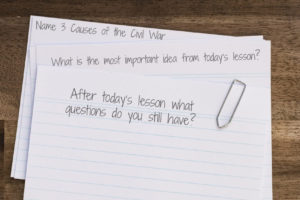Has anyone noticed how little eye contact there seems to be these days? I was wondering if it was just me or if there has truly been a decline in eye contact. So I went searching and what I found was quite interesting.
Adults these days are making eye contact somewhere between 30% – 60% of the time in an average conversation, according to research from a communications-analytics company. These numbers seemed fairly high to me, until I read further.
I was surprised by what I discovered.
A Mini-Experiment in Listening
I know some teachers who recently conducted a mini-experiment. For one day, whenever they were speaking with someone, adult or child, they gave them their full attention. This meant they stopped what they were doing, cleared away distractions, and made eye contact. They prepared themselves to truly listen to what they other person had to say.
When I asked them to share their experience, it was eye-opening (pun intended ;-).
They had three primary insights:
1) They observed that most people around them did not stop what they were doing to give their full attention when they were talking with someone,
2) They realized how difficult it was for them to stop what they were doing and make eye contact with the person they were talking to, and
3) When they gave their full attention to the person they were speaking to, they felt “more in tune” with the person in the moment.
Who would have thought we would be at a time in our history when making eye contact would become such a challenge? I call it the “fall-out” of our multi-tasking and digital world.
Here’s the thing. If we go back to those opening numbers, I think you’ll see why this is such a big deal.
Creating a Sense of Emotional Connection
Although adults make eye contact between 30% – 60% of the time in a given conversation, the research also says that in order to “create a sense of emotional connection” when speaking with someone, the eye contact between people should be 60% – 70% of the time.
Uh-oh!
Teachers have few options but to multi-task throughout the day. They hit the ground running first thing in the morning and don’t stop, often until the fall into bed in the evening. Dings, chirps, chimes, as well as FOMO (fear of missing out) are driving our behavior in so many ways and we don’t even realize it.
We not only need, but also benefit from, a sense of emotional connection with our colleagues and our students. But we aren’t holding eye contact long enough to create it with the people we are speaking to.
For the “connected” world we live in, we seem awfully “disconnected.”
Cereal Boxes or Teachers?
For children, the research shows that “‘Making eye contact even with a character on a cereal box inspires powerful feelings of connection,’ said Brian Wansink, a professor at Cornell’s Dyson School of Applied Economics and Management.”
Why wouldn’t we as teachers want to be the ones to inspire those same powerful feelings of connection?
When teachers make eye contact it makes a difference. The research shows “only actual eye contact fully activates those parts of the brain that allow us to more acutely and accurately process another person’s feelings and intentions.” Think of making eye contact as a “cognitive jump-start.”
There are even more benefits. The research also shows that “eye contact makes us more socially aware and empathetic. It allows us to make sense of our relationships . . .” and eye contact sets us up two individuals for a “richer mode of communication.”
More than ever, we need to be intentional about taking the few extra seconds or minutes, however long it takes, to stop what we are doing, clear away distractions, and make eye contact so we can create those moments of connection with our colleagues and our students by truly listening.
A Simple Challenge for You Today
Conduct your own mini-experiment.
Today, be intentional. Whenever you have a conversation with someone, stop what you are doing, clear away distractions (mental and physical), and make eye contact.
What difference did it make?
Reflect on what you discovered about others, about yourself, and the difference that giving someone your full attention makes for both you and the other person.
Let me know how your mini-experiment goes and what you discovered. Leave a comment below.




